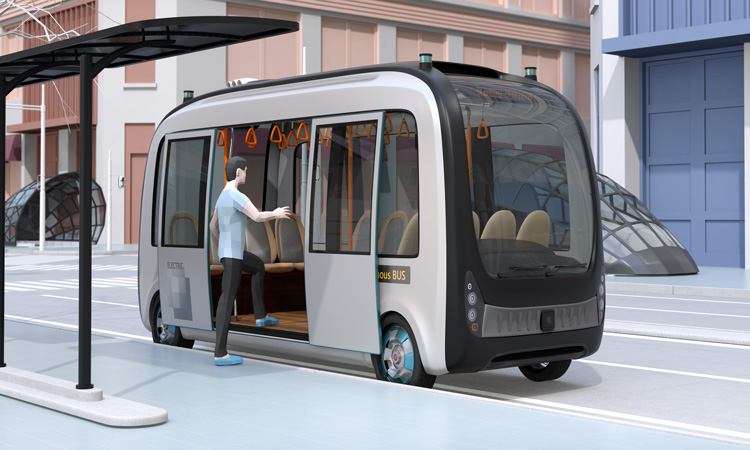Putting people and the planet at the heart of urban mobility
- Like
- Digg
- Del
- Tumblr
- VKontakte
- Buffer
- Love This
- Odnoklassniki
- Meneame
- Blogger
- Amazon
- Yahoo Mail
- Gmail
- AOL
- Newsvine
- HackerNews
- Evernote
- MySpace
- Mail.ru
- Viadeo
- Line
- Comments
- Yummly
- SMS
- Viber
- Telegram
- Subscribe
- Skype
- Facebook Messenger
- Kakao
- LiveJournal
- Yammer
- Edgar
- Fintel
- Mix
- Instapaper
- Copy Link
Posted: 12 August 2022 | Marla Westervelt - Coalition for Reimagined Mobility | No comments yet
Marla Westervelt, Vice President of Policy at the Coalition for Reimagined Mobility, speaks with Intelligent Transport’s Leah Hockley about the significant role that policymakers play in the design and deployment of public transport services, as well as how public policies can help to improve transit equity while fostering sustainable urban transport.


Can you tell us about the Coalition for Reimagined Mobility and the company’s role in supporting the creation of public policies that make transport more accessible for communities?
The Coalition for Reimagined Mobility (ReMo) brings together former policymakers and CEOs from around the world in order to develop policy solutions that better prioritise people and the planet. We were officially launched in February 2021, and our supporters include people like our Co-Chair Jim Farley from Ford, and our Co-Chair Mary Nichols, who was formerly the Chair of the California Air Resources Board, and many more key industry players. We’re working to develop policy solutions that contend with all of these new technology changes that we are seeing and figure out ways to implement them in our future, but in a way that is putting people first, rather than the technological solution first.
How significant a role does public policy play in improving equity for transport users?
Policymakers really are the core of ensuring that we are able to have services that really meet the needs of the passengers”
Public policymakers and government officials play a critical role in ensuring that the public interest is served, and that looks different around the world. In some places in the world, the public sector is the only operator of any transportation service. In that context, the public policymaker’s job is to operate a mobility service in a way that is affordable, equitable, accessible and safe. The public policymaker also needs to pay for that full service and develop the parameters.
However, there are other places around the world where the public policymaker’s job is to set parameters for private sector operators – or, sometimes, a combination of both public and private sector operators – in order to achieve the same thing: to ensure that we can have services that are affordable, equitable and accessible, as well as safe. In that context, it might mean that, in addition to developing parameters for operation, it’s also necessary to distribute money out to public and private sector operators, to ensure that they’re able to deliver their services in a sustainable fashion. Essentially, policymakers really are the core of ensuring that we are able to have services that really meet the needs of the passengers.
What factors are taken into consideration when developing public policies that foster sustainable urban transport?
It certainly depends, again, on where we are in the world. But, from my perspective, a policymaker needs to consider two things when thinking about fostering sustainable transportation. First, how is that sustainable transportation mode going to be paid for? Secondly, how do we ensure that there is a sustainable funding stream, not only for capital investment, but also for ongoing operations? I think that this is a really critical point that ReMo is trying to bring to the fore, because it is not necessarily profitable to operate in a way that’s in the public interest. Therefore, these aspects need to be considered right from the beginning.
In addition to that, we need to ensure that we are providing options that are low carbon. Low carbon can include a variety of different things. It can include the electrification of various public transport services, or the use of alternative fuels that release lower emissions in comparison to typical fossil fuel. It could also include the use of high-capacity options, which are always the most efficient and sustainable options, to get from point A to point B. This includes the use of a heavy subway, or a heavy rail line that can hold a lot of people.
It is important to consider the needs of the people – their travel patterns, where they need to go and the times of day that they are travelling – as well as how we can make sure that services are both economically and environmentally sustainable”
However, when looking at a broader transportation network, it is important to consider the needs of the people – their travel patterns, where they need to go and the times of day that they are travelling – as well as how we can make sure that services are both economically and environmentally sustainable. There’s also a third aspect that’s worth bringing up, which is thinking about how we can make these services sustainable for people. For example, putting everyone in a single occupancy vehicle in a dense urban area is not going to be sustainable, even if all of those vehicles are electric, as there’s simply not enough space for them.
Another aspect that needs to be considered is that we are often forced to build our cities and urban areas around cars, rather than people, which data demonstrates reduces the quality of life in urban areas.


Why do you think it’s important for public and private sectors to work together, to form these policies that best meet public interest?
One of my greatest passions is developing policy solutions that align the interests of public and private sectors. We live in a market-driven society, which is great. This means that private sector innovators come up with fantastic ideas, and move the needle forward. That’s the job that they need to do, while the public sector’s job is to ensure the public interest.
In order to ensure that we’re able to have innovative solutions that are continually on the cutting edge and are able to reduce carbon emissions to make sure that we have liveable cities… we need to bring both sectors together”
Therefore, in order to ensure that we’re able to have innovative solutions that are continually on the cutting edge and are able to reduce carbon emissions to make sure that we have liveable cities, but also do it in a way that is affordable and sustainable, while considering other public goals, we need to bring both sectors together. One of the things that ReMo really focuses on is, what are the goals of the private sector? What are the goals of the public sector? How do we bring those goals together, and what are the trade-offs that we need to make to bring those goals together?
Both research into these conversations and bringing stakeholders together to discuss these concerns helps to bring the two sectors together. It can be challenging, depending on what sector you’re talking about, because we may have perceptions that our goals on the public side or the private side could never be aligned, but we’re all trying to provide services that make peoples’ lives better. So, there’s always an opportunity to bring that alignment together.
What work is being done to support the development of public policies that address newer modes of transport, such as electric, autonomous and shared mobility?
We will be looking into the broader transportation ecosystems, and how we can allocate funding to ensure that there are robust mobility options”
We are currently looking into this, and are developing a report that’s going to be launched at COP27 later in 2022. Through this report, we will be looking into the broader transportation ecosystems, and how we can allocate funding to ensure that there are robust mobility options. The way that we look at this is, regardless of whether the service is an autonomous vehicle or driven by a person, it still requires the same infrastructure and parameters, as well as financial sustainability, to be able to get from point A to point B, and to be able to operate these services sustainably.
We are trying to develop policy solutions that will allow policymakers to be empowered to put down those parameters. But, I think that the most important point thing here is, whether we’re talking about a scooter, autonomous vehicle, micro-transit or high-capacity transportation, the foundational things that you need to enable any of these services are extremely similar. The upfront capital investment certainly varies across each of these, but you have to have a policy framework that enables each of these modes, so that people have the choice to use the mode that best fits each trip that they’re taking at any given time.


How do you think public policies will influence the future of mobility?
I think that public policymakers won’t just influence mobility, they’ll determine what the future looks like. I’ve been pointing to public policymakers, because their job is to set parameters and distribute funding, to ensure that we’re operating in the public interest. There’s a scenario in which we do nothing different than we are doing right now; this scenario is likely going to result in having fewer options for fewer people. It is a trajectory that means that we’re divesting in transportation service operation, that we are promoting single occupancy vehicles, or personal car ownership. This is a scenario that is likely not as sustainable.
Public policymakers won’t just influence mobility, they’ll determine what the future looks like… policymakers have this huge potential right now, to reimagine how they should be distributing funding, and also setting up those parameters”
Policymakers also have this huge potential right now, to reimagine how they should be distributing funding, and also setting up those parameters. They can also enable a future where everyone has at least two options for any trip that they want to take at any given time, and that those options are affordable, accessible and safe, and that they’re operated within a community that is also friendly to pedestrians and cyclists.
I think that public policymakers really hold the key power here, but they have to make the right decisions in order to see a future that looks like the one that, at least, the Coalition for Reimagined Mobility is hoping to see.
The Coalition for Reimagined Mobility recently published a new report, titled ‘Solving the Global Supply Chain Crisis with Data Sharing’. Can you tell us more about the report and its findings?
Our report was launched just a few weeks ago, at the end of June 2022. It looks into answering the question, how do we reduce emissions within the freight sector?
The key recommendations that we took away from [the research] is that we need to develop and deploy freight open data exchange standards, which can allow everyone to have a similar way to communicate the data that they need to enable operation”
Largely, the freight sector has been focusing on electrification, or shifting to alternative fuels to reduce emissions. The timelines for fully achieving these are extremely long and will not get us in line with any 2050 goals. I was at an event at COP26 in 2021, where someone raised their hand and said: “Everything we’re talking about is fantastic, except for the fact that we’re not going to get there. So, what else can we do?” In this report, we looked into that question. What we found is that freight is incredibly inefficient, with 20 per cent of our freight miles on empty vehicles, and freight systems are constantly idling.
There’s a huge opportunity to reduce these inefficiencies, by improving the way in which we communicate. Our paper looked into seven different operational efficiencies, and how they would impact the ultimate emissions within the sector. We found that these efficiencies would reduce emissions by 22 per cent. Therefore, we developed a model effort for that. We also conducted three case studies, where we looked into different ports around the world and how they are beginning to implement new digital infrastructure, as well as the lessons that we can learn from them. The key recommendations that we took away from that, is that we need to develop and deploy freight open data exchange standards, which can allow everyone to have a similar way to communicate the data that they need to enable operation, and that governments really need to take the lead on implementing it.
There have been a lot of efforts on the private side but, without having specific governmental leadership, it’s really hard to develop a system that is truly going to provide everyone with access, and won’t just be for the wealthiest corporations out there. So, we’re extremely excited about this work, and I’m really excited about the uptake that its gotten thus far. I think it’s a huge opportunity to be able to use the technology that we have today to reduce emissions pretty drastically within the freight sector.


Drawing from your personal experience, what has been the best public transport system that you have used, and why?
But, to me, some of the grit is what I like most about public transportation. I think of it as a bit of an adventure”
This is a really fun question! Usually, when you think of the best transport system, you think of a service that has really short headways, so it’s always available, really clean, or you’re always going to get a seat. But, to me, some of the grit is what I like most about public transportation. I think of it as a bit of an adventure.
So, I’m going to select a system that is near and dear to my heart, which is LA Metro, where I used to work in the Office of Extraordinary Innovation. While Los Angeles is not known for having robust transportation, the investments that are being made on the system right now are incredible. They’re investing $40 billion over 40 years. That’s a lot of money, and the services that it is building out, and beginning to provide, such as its micro-transit services and all of the rail extensions, are so exciting to me. Therefore, I would say that that is the service that I love, and I’m most excited about. I look forward to seeing what LA Metro does in this next iteration, as it prepares for the Olympics in just a few years’ time.


Related topics
Accessibility, Alternative Power, Mobility Services, Passenger Experience, Public Transport, Sustainable Urban Transport, Transport Governance & Policy
Related modes
Boat, Bus & Coach, Rail
Related cities
Los Angeles
Related countries
United States
Related organisations
Coalition for Reimagined Mobility, LA Metro
Related people
Jim Farley, Marla Westervelt, Mary Nichols








